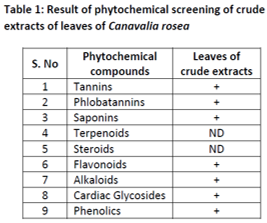Abstract
Leaves of Canavalia rosea were shade dried, powdered and was extracted using nine solvents Ethanol, Methanol, Chloroform, Acetone, Benzene, Dichloromethane, Petroleum ether, Hexane and Aqueous. Preliminary phytochemical screening of the crude extracts revealed the presence of tannins, phlobatannins, saponins, flavonoids, alkaloids, cardiac glycosides and phenolics. The presence of these bioactive constituents is associated with the antimicrobial activity of the plant. Agar well diffusion method revealed high activity against microorganisms, Bacillus cereus; Bacillus megaterium; Bacillus stearothemophilus, Bacillus subtilis, Staphylococcus aureus, and Streptococcus faecalis a group of gram- positive bacteria that frequently cause enteric infections in humans. Gram negative bacteria were not as susceptible as gram- positive bacteria. Minimum inhibitory concentration (MIC) and minimum bactericidal concentration (MBC) values ranged from 0.03mg/ml to 2 mg/ml and 0.12 to 4 mg/ml respectively. The results confirm that C. rosea can be used as source of drugs to fight infections caused by susceptible bacteria.
Full text article
Authors

This work is licensed under a Creative Commons Attribution-NonCommercial-NoDerivatives 4.0 International License.

